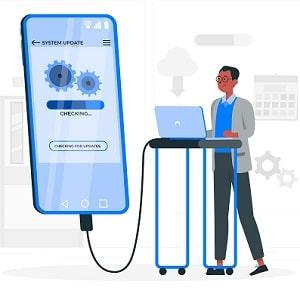In today’s digital era, software applications have become an integral part of our daily lives, seamlessly connecting us to information, services, and entertainment. With the ever-increasing diversity of devices and platforms, ensuring these applications’ performance, stability, and usability across real devices has become paramount. This is where device testing plays a crucial role.
Device testing involves evaluating software applications on various real devices to identify and rectify issues that may arise due to device-specific factors such as screen resolution, memory constraints, network connectivity, and more. It allows developers and QA teams to uncover bugs, optimize performance, and enhance the user experience.
However, device testing is not a one-time activity. It requires continuous improvement to keep up with the evolving landscape of devices and user expectations. To achieve this, it is essential to track and measure key metrics that provide insights into the effectiveness and efficiency of the testing process.
6 Real Device Testing Metrics to Track
 In this blog, we will explore six real device testing metrics that are crucial to track for continuous improvement. These metrics will help you gauge the coverage of your testing efforts, identify performance bottlenecks, optimize resource consumption, and ultimately deliver high-quality applications that delight users across a wide range of devices.
In this blog, we will explore six real device testing metrics that are crucial to track for continuous improvement. These metrics will help you gauge the coverage of your testing efforts, identify performance bottlenecks, optimize resource consumption, and ultimately deliver high-quality applications that delight users across a wide range of devices.
By understanding and leveraging these metrics, you can continuously improve your device testing strategy, ensuring that your applications are thoroughly tested, performant, and compatible with the devices your users rely on.
So, let’s dive into the world of device testing metrics and discover how they can empower you to deliver exceptional user experiences on real devices.
#1. Device Compatibility
Device compatibility is a critical aspect of device testing. It ensures a device functions properly across various platforms, operating systems, and browsers. Testing device compatibility is essential because users access applications and websites from a wide range of devices, and each device may have different screen resolutions, operating system versions, and browser configurations.
To measure device compatibility, several metrics can be used. These include
- Screen resolution: Test the application or website on different screen resolutions to ensure proper rendering and alignment of content.
- OS version: Test the device on different operating system versions to identify any compatibility issues specific to certain versions.
- Browser compatibility: Test the application or website on different browsers (such as Chrome, Firefox, Safari, and Edge) to ensure consistent functionality and appearance.
To improve compatibility testing, consider the following strategies:
- Use virtual environments: Utilize virtual machines or cloud-based testing platforms that allow you to test on different devices, operating systems, and browsers without the need for physical devices.
- Build a comprehensive test matrix: Create a matrix that includes various device configurations, such as different screen sizes, OS versions, and browser combinations. This matrix can serve as a guide for thorough testing.
- Regularly update device profiles: Keep device profiles up to date with the latest market trends and user preferences to ensure comprehensive compatibility testing.
- Use Cloud-based platforms: A cloud-based platform like LambdaTest is a unified intelligent digital experience testing platform that enables developers and testers to perform manual and automation testing on their web and mobile applications over 3000+ browsers and OS combinations, and execute tests parallelly on different environments, thus improving software quality and reducing test execution time. LambdaTest also offers integration with various CI/CD tools like Jenkins for ease of the process. With LambdaTest, developers and testers can execute their tests as per their choice of test automation frameworks and their supported languages from various options like Selenium, Appium, and Playwright.
#2. Performance and Speed
Performance and speed are key factors contributing to a positive user experience. Slow load times, unresponsive interfaces, and excessive resource consumption can frustrate users and lead to the abandonment of the device or application. Therefore, performance testing is crucial to identify bottlenecks and optimize device performance.
To evaluate device performance, consider the following metrics:
- Load time: Measure the time it takes to load an application or website. A faster load time indicates better performance.
- Response time: Measure the time it takes for the device to respond to user actions, such as clicks or inputs. A quicker response time enhances user experience.
- Resource consumption: Monitor the device’s utilization of system resources, such as CPU, memory, and network bandwidth. High resource consumption can degrade performance and impact other applications running concurrently.
To enhance device performance and speed, employ the following techniques:
- Code optimization: Optimize the codebase by identifying and eliminating performance bottlenecks, reducing redundant operations, and improving algorithm efficiency.
- Caching and compression: Implement caching mechanisms to store frequently accessed data locally and compress files to reduce bandwidth usage and improve load times.
- Network optimization: Optimize network communication by minimizing unnecessary requests, reducing payload size, and leveraging techniques like content delivery networks (CDNs) to serve static content.
#3. Battery Life
Battery life is a crucial consideration for mobile devices, directly affecting user convenience and satisfaction. Extensive battery drain can result in frequent recharging or limited device usage, negatively impacting user experience. Therefore, testing battery life is essential to ensure optimal device performance.
To measure battery performance, consider the following metrics:
- Standby time: Measure the duration a device can remain idle with minimal power consumption before the battery is depleted.
- Talk time: Measure the duration a device can sustain continuous voice calls before the battery is drained.
- Usage under different conditions: Test the device’s battery life under different scenarios, such as multimedia playback, internet browsing, and GPS usage, to assess its performance across various activities.
To optimize battery life in devices, consider implementing the following tips:
- Power-efficient coding: Develop applications and software with efficient coding practices that minimize unnecessary battery consumption, such as optimizing resource usage and reducing background processes.
- Battery optimization settings: Provide users with options to enable power-saving modes or adjust settings that can prolong battery life
- Background processes management: Ensure that unnecessary background processes and services are minimized or adequately managed to avoid unnecessary battery drain.
- Screen brightness and timeout: Encourage users to adjust screen brightness and set an appropriate screen timeout period to conserve battery power.
- Efficient power management: Implement power-saving features, such as intelligent CPU throttling, network connectivity optimization, and efficient battery usage algorithms, to maximize battery performance.
- Battery usage analytics: Incorporate battery usage analytics within the device to monitor and identify power-hungry applications or features that significantly impact battery life.
Regular testing and battery life optimization are necessary to ensure that devices provide an optimal user experience and meet the expectations of users who rely on their devices for extended periods.
In conclusion, device compatibility, performance and speed, and battery life are vital metrics to track for continuous improvement in device testing. By measuring and optimizing these metrics, developers, and manufacturers can enhance the user experience, maximize device performance, and ensure longer battery life. Implementing comprehensive testing strategies, utilizing relevant metrics, and applying effective optimization techniques will improve device quality and user satisfaction.
#4. Network Connectivity
In today’s interconnected world, network connectivity plays a crucial role in the functionality and performance of devices. Testing network connectivity ensures that devices can effectively connect to the internet, communicate with servers, and deliver a seamless user experience. It is essential to evaluate various aspects of network performance to identify potential issues and optimize connectivity.
Here are some critical metrics for evaluating network performance:
- Download/upload speed: Measure how data can be downloaded from or uploaded to the network. Faster speeds indicate better network performance and efficient data transfer.
- Latency: Measure the delay between sending a request and receiving a response. Lower latency results in faster and more responsive network interactions.
- Signal strength: Assess the strength and stability of the network signal. Weak signal strength can lead to poor connectivity, slow data transfer, and dropped connections.
To enhance network connectivity testing, consider the following strategies:
- Test in various network conditions: Evaluate device performance under different network scenarios, such as varying bandwidth, high latency, or intermittent connectivity. This helps identify potential issues and optimize performance in real-world situations.
- Emulate network environments: Use network emulators to simulate different network conditions and test device behavior under those conditions. This allows for controlled and repeatable testing.
- Prioritize network optimization: Implement optimization techniques, such as data compression, caching, and adaptive streaming, to enhance network performance and ensure a seamless user experience.
- Monitor real-time network performance: Monitor network performance metrics during testing to identify fluctuations, bottlenecks, or network-related issues that may impact device performance.
#5. Usability and User Experience
Usability testing is vital to device testing, focusing on how users interact with devices, applications, or websites. It ensures that devices are intuitive and efficient and provides a positive user experience. By evaluating key usability metrics, developers can identify areas for improvement and enhance the overall usability of their devices.
Here are some essential metrics to assess usability and user experience:
- Navigation: Evaluate how easily users can navigate menus, screens, or pages within the device or application. Straightforward and intuitive navigation ensures efficient user interactions.
- Responsiveness: Measure the device’s response time to user actions, such as taps, swipes, or clicks. A fast and smooth response contributes to a seamless user experience.
- User satisfaction: Collect user feedback through surveys or user testing sessions to gauge their satisfaction level. User satisfaction is an essential metric that reflects the overall usability of the device.
- Error rates: Measure the frequency and severity of user errors while interacting with the device or application. Low error rates indicate a more user-friendly interface.
To improve usability and enhance user experience, consider the following approaches:
- User-centered design: Involve users throughout the design and development process to gather feedback, conduct usability testing sessions, and incorporate user preferences and expectations.
- Simplify interface and interactions: Streamline the device’s interface, eliminate unnecessary complexity, and ensure clear and concise instructions or labels. Simplifying interactions reduces cognitive load and improves usability.
- Consistency across platforms: Maintain consistency in design elements, interaction patterns, and terminology across different platforms (e.g., mobile, web) to create a familiar and cohesive user experience.
- Continuous user feedback: Establish channels for users to provide feedback and actively monitor and analyze user feedback to identify pain points, usability issues, and areas for improvement.
#6. Security and Data Privacy
In today’s digital landscape, ensuring devices’ security and data privacy is paramount. Rigorous testing is necessary to identify vulnerabilities, mitigate risks, and maintain user trust. Security and data privacy testing should encompass various aspects, including system security, data encryption, access controls, and compliance with privacy regulations.
Here are some key metrics to consider in security and data privacy testing:
- Security vulnerabilities: Identify and measure the number and severity of security vulnerabilities within the device or application. This includes authentication, authorization, input validation, and secure data transmission vulnerabilities.
- Data breaches: Monitor and track any instances of unauthorized access, data leaks, or breaches of sensitive information. Measure the impact of the potential violations and evaluate the effectiveness of security controls.
- Privacy Compliance: Assess the device’s compliance with privacy regulations, such as GDPR (General Data Protection Regulation) or CCPA (California Consumer Privacy Act). Measure the device’s adherence to privacy principles, data consent mechanisms, and user data protection practices.
To enhance device security and data privacy, consider the following best practices:
- Threat modeling: Conduct a comprehensive analysis of potential threats and risks to the device’s security and data privacy. This includes identifying attack vectors, potential vulnerabilities, and mitigation strategies.
- Penetration testing: Perform controlled, simulated attacks on the device or application to identify vulnerabilities and weaknesses in the security infrastructure. This helps uncover potential areas of exploitation and provides insights for strengthening security measures.
- Encryption and secure protocols: Implement robust encryption algorithms and secure communication protocols to protect sensitive data in transit and at rest. This includes using SSL/TLS for secure communication and encryption techniques for data storage.
- User access controls: Implement robust user authentication mechanisms, access controls, and authorization frameworks to ensure that only authorized users can access sensitive information or perform critical actions.
- Regular security updates: Stay proactive by applying security patches, updates, and fixes to address known vulnerabilities and protect against emerging threats.
- Privacy by design: Incorporate privacy considerations from the early stages of device design and development. Implement privacy-enhancing features such as data minimization, user consent mechanisms, and privacy impact assessments.
Conclusion
Tracking and continuously improving the six real device testing metrics discussed in this article – device compatibility, performance and speed, battery life, network connectivity, usability and user experience, and security and data privacy – are essential for achieving continuous improvement in device quality and user satisfaction.
By monitoring and optimizing these metrics, manufacturers, and developers can ensure that their devices function seamlessly across various platforms and configurations, deliver faster performance and improved user experiences, offer longer battery life, maintain reliable network connectivity, provide intuitive interfaces, and prioritize security and data privacy.
Implementing robust testing methodologies, utilizing relevant metrics, and incorporating user feedback throughout the development process is crucial to continuous improvement. Additionally, staying updated with the latest trends, technologies, and regulations in the industry will help manufacturers and developers meet users’ evolving expectations and deliver exceptional devices.
Ultimately, manufacturers can enhance their devices’ quality, functionality, and overall user satisfaction by tracking and improving these metrics. Embracing a continuous improvement mindset and consistently striving for excellence in device testing will enable companies to stay competitive in the ever-changing technological landscape.




